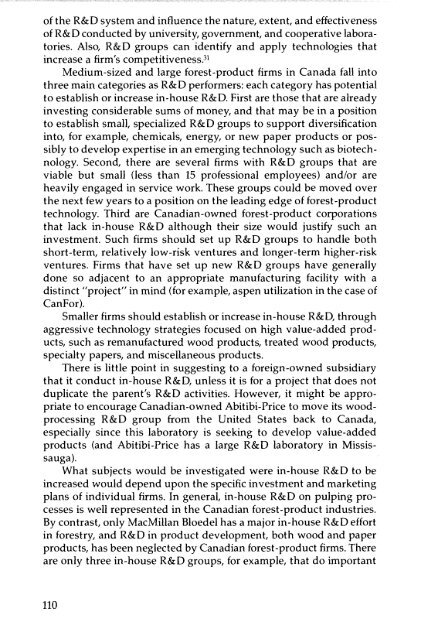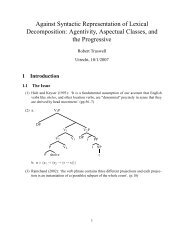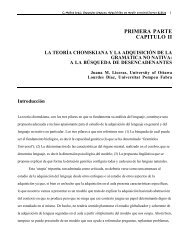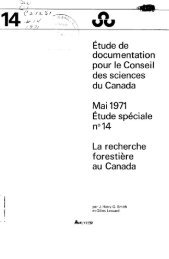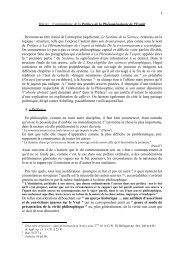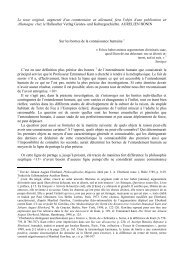of <strong>the</strong> R&D system <strong>and</strong> influence <strong>the</strong> nature, extent, <strong>and</strong> effectivenessof R&D conducted by university, government, <strong>and</strong> cooperative laboratories.Also, R&D groups can identify <strong>and</strong> apply technologies thatincrease a firm's competitiveness."Medium-sized <strong>and</strong> large forest-product firms in Canada fall intothree main categories as R&D performers: each category has potentialto establish or increase in-house R&D. First are those that are alreadyinvesting considerable sums of money, <strong>and</strong> that may be in a positionto establish small, specialized R&D groups to support diversificationinto, for example, chemicals, energy, or new paper products or possiblyto develop expertise in an emerging technology such as biotechnology.Second, <strong>the</strong>re are several firms with R&D groups that areviable but small (less than 15 professional employees) <strong>and</strong>/or areheavily engaged in service work. These groups could be moved over<strong>the</strong> next few years to a position on <strong>the</strong> leading edge of forest-producttechnology. Third are <strong>Canadian</strong>-owned forest-product corporationsthat lack in-house R&D although <strong>the</strong>ir size would justify such aninvestment. Such firms should set up R&D groups to h<strong>and</strong>le bothshort-term, relatively low-risk ventures <strong>and</strong> longer-term higher-riskventures. Firms that have set up new R&D groups have generallydone so adjacent to an appropriate manufacturing facility with adistinct "project" in mind (for example, aspen utilization in <strong>the</strong> case ofCanFor).Smaller firms should establish or increase in-house R&D, throughaggressive technology strategies focused on high value-added products,such as remanufactured wood products, treated wood products,specialty papers, <strong>and</strong> miscellaneous products.There is little point in suggesting to a foreign-owned subsidiarythat it conduct in-house R&D, unless it is for a project that does notduplicate <strong>the</strong> parent's R&D activities. However, it might be appropriateto encourage <strong>Canadian</strong>-owned Abitibi-Price to move its woodprocessingR&D group from <strong>the</strong> United States back to Canada,especially since this laboratory is seeking to develop value-addedproducts (<strong>and</strong> Abitibi-Price has a large R&D laboratory in Mississauga).What subjects would be investigated were in-house R&D to beincreased would depend upon <strong>the</strong> specific investment <strong>and</strong> marketingplans of individual firms. In general, in-house R&D on pulping processesis well represented in <strong>the</strong> <strong>Canadian</strong> forest-product industries.By contrast, only MacMillan Bloedel has a major in-house R&D effortin forestry, <strong>and</strong> R&D in product development, both wood <strong>and</strong> paperproducts, has been neglected by <strong>Canadian</strong> forest-product firms. Thereare only three in-house R&D groups, for example, that do important110
wood-product-related research. In-house R&D on forestry <strong>and</strong>product development is urgently needed.To help stimulate R&D in <strong>the</strong> economy as a whole <strong>the</strong> federalgovernment offers significant tax incentives. Given that R&D ischaracterized by indivisibility (high fixed costs), inappropriability(firms investing in R&D can rarely capture all <strong>the</strong> benefits), <strong>and</strong>uncertainty (<strong>the</strong> occurrence of failure) such government support iswarranted <strong>and</strong> should be maintained. In addition, <strong>the</strong> federalgovernment should seriously consider a proposal by MacMillanBloedel that essentially would allow a corporation to treat R&D expendituresas tax credits, which can be written off when <strong>the</strong> firm has netincome.v O<strong>the</strong>r than this no new tax incentives are required. And,forest-product firms are not strong users of existing R&D subsidies. Inthis industry, technology is normally transferred as part of a largecapital investment. Government initiatives that promote innovativenessin investment decision-making can potentially provide a strongincentive to in-house R&D by increasing <strong>the</strong> level of return on <strong>the</strong>R&D dollar.The Role of <strong>the</strong> Cooperative LaboratoriesMany forest-product firms, including firms with <strong>and</strong> without inhouseR& D, contribute toward financing <strong>the</strong> cooperative laboratories.These laboratories, notably Feric, Forintek, <strong>and</strong> Paprican, provide <strong>the</strong><strong>Canadian</strong> forest-product industries with valuable <strong>and</strong> scarce technologicalresources. In particular, <strong>the</strong>y offer large pools of highly trainedtechnically qualified people (<strong>and</strong> particularly in <strong>the</strong> case of Paprican,of highly trained scientists), who offer complementary technologicalexpertise in wood harvesting (Feric), wood-processing (Forintek), <strong>and</strong>pulp <strong>and</strong> paper (Paprican). They are significant components of <strong>the</strong>technological infrastructure of <strong>the</strong> <strong>Canadian</strong> forest-product industries.This author recommends that industry <strong>and</strong> government continueto support <strong>the</strong> activities of Feric, Forintek, <strong>and</strong> Paprican.The challenge facing Feric, Forintek, <strong>and</strong> Paprican is to ensure that<strong>the</strong>ir potential to enhance technological change is maximized to <strong>the</strong>benefit of <strong>the</strong> <strong>Canadian</strong> forest-product industries <strong>and</strong> <strong>the</strong> <strong>Canadian</strong>economy.Clearly, Feric, Forintek <strong>and</strong> Paprican respond, albeit creatively, to<strong>the</strong> dem<strong>and</strong>s of <strong>the</strong>ir public <strong>and</strong> private membership. But <strong>the</strong> membershipof <strong>the</strong>se organizations, especially Feric <strong>and</strong> Forintek, is diverse:industry members, for example, vary in terms of size <strong>and</strong> scope of111
- Page 3 and 4:
Science Council of Canada100 Metcal
- Page 5 and 6:
ContentsForewordAcknowledgments1113
- Page 7 and 8:
In-House R&D by Equipment Suppliers
- Page 9 and 10:
Table 2.5: R&D Employment in 10 Can
- Page 11 and 12:
ForewordTechnological innovation an
- Page 14 and 15:
adapted sufficiently rapidly to the
- Page 16 and 17:
Finally, the author interviewed sen
- Page 18 and 19:
Table 1.3: Degree of Foreign Contro
- Page 20 and 21:
Figure 1.1: Innovation Patterns and
- Page 22 and 23:
Since 1945 the pace of technologica
- Page 24 and 25:
Toward Reliance on Research rather
- Page 26 and 27:
science occurred between 1900 and 1
- Page 28 and 29:
Forestry Sector R&D SystemIn Canada
- Page 30 and 31:
up its forestry research group at N
- Page 32 and 33:
and one other that was strongly ori
- Page 34 and 35:
closely involved in the establishme
- Page 36 and 37:
to vet and control research priorit
- Page 38 and 39:
In-House R&D by Equipment Suppliers
- Page 40 and 41:
product. One, by no means atypical,
- Page 42 and 43:
only internal source of dissolving
- Page 44 and 45:
of which only 18 per cent came from
- Page 46 and 47:
New information can be generated by
- Page 48 and 49:
Chapter 3The R&D System andHow It W
- Page 50 and 51:
Table 3.2: Summary Characteristics
- Page 52 and 53:
Sixteen firms provided details on s
- Page 54 and 55:
The Opco Process: A Case Study of I
- Page 56 and 57:
however, within the last two decade
- Page 58 and 59: in 1959, and a full-scale experimen
- Page 60 and 61: Papritection was developed as follo
- Page 62 and 63: Further tests were conducted in 198
- Page 64 and 65: fully automatic machines, and its s
- Page 66 and 67: Chapter 4Technological Capability a
- Page 68 and 69: Table 4.2 provides measurements of
- Page 70 and 71: forest-product equipment patents, w
- Page 72 and 73: Foreign-Ownership and In-House R&DT
- Page 74 and 75: Technological Liaisons: Forest-Prod
- Page 76 and 77: for this deficiency the federal gov
- Page 78 and 79: On the other hand, three of the lea
- Page 80 and 81: one of Sweden's forest-products gia
- Page 82 and 83: Capital Investments in the Canadian
- Page 84 and 85: and Quebec accounted for 33.9 per c
- Page 86 and 87: Table 5.5: Canadian Forest-Product
- Page 88 and 89: Scandinavian manufacturers are in t
- Page 90 and 91: was implemented smoothly and manage
- Page 92 and 93: the foundations were poured, until
- Page 94 and 95: inherent capabilities were never fu
- Page 96 and 97: especially in the east, has receive
- Page 98 and 99: "export staples mentality." The bel
- Page 100 and 101: size of the conglomerates would cer
- Page 102 and 103: the concept of flexibility explicit
- Page 104 and 105: This author therefore recommends th
- Page 106 and 107: with respect to technology transfer
- Page 110 and 111: operations, attitudes toward innova
- Page 112 and 113: limited R&D base, but they do empha
- Page 114 and 115: The small size and non-innovative n
- Page 116 and 117: Promoting In-House R&D in the Fores
- Page 118 and 119: Notes1. The Technological Challenge
- Page 120 and 121: 7. For example, nj. Daly, "Weak Lin
- Page 122 and 123: 7. P.G. Mellgren and E. Heidersdorf
- Page 124 and 125: this R&D facility has become even s
- Page 126 and 127: 3. K. Noble, "Forest Industry Urged
- Page 128 and 129: Publications of the ScienceCouncil
- Page 130 and 131: Reports on Matters Referred by the
- Page 132 and 133: No. 40. Government Regulation of th
- Page 134 and 135: 1981An Engineer's View of Science E


